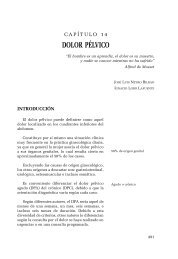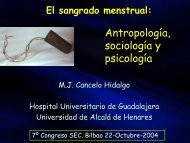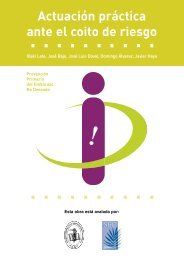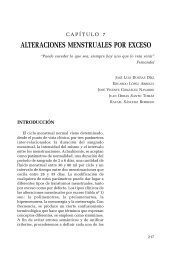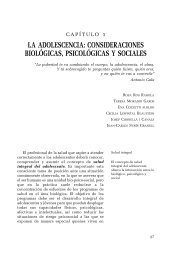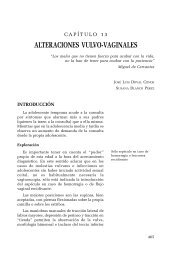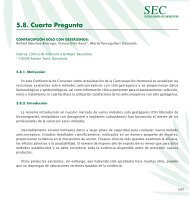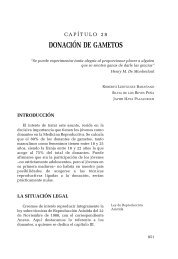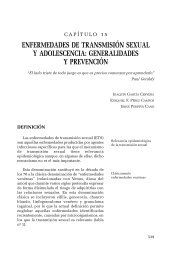4.9. CONTRACEPCIÓN DE EMERGENCIA - Sociedad Española de ...
4.9. CONTRACEPCIÓN DE EMERGENCIA - Sociedad Española de ...
4.9. CONTRACEPCIÓN DE EMERGENCIA - Sociedad Española de ...
Create successful ePaper yourself
Turn your PDF publications into a flip-book with our unique Google optimized e-Paper software.
<strong>4.9.</strong> <strong>CONTRACEPCIÓN</strong> <strong>DE</strong> <strong>EMERGENCIA</strong><br />
<strong>4.9.</strong>1. INTRODUCCIÓN<br />
SOCIEDAD ESPAÑOLA <strong>DE</strong> <strong>CONTRACEPCIÓN</strong><br />
La contracepción postcoital <strong>de</strong> emergencia pue<strong>de</strong> <strong>de</strong>finirse como la utilización <strong>de</strong> un medicamento o<br />
dispositivo intrauterino (DIU) con el objetivo <strong>de</strong> prevenir un embarazo <strong>de</strong>spués <strong>de</strong> un coito no protegido<br />
o fallo <strong>de</strong> un método anticonceptivo.<br />
<strong>4.9.</strong>1.1. Métodos existentes:<br />
El método <strong>de</strong> Yuzpe, que consiste en dos dosis <strong>de</strong> 100 µg <strong>de</strong> etinil-estraiol y 500 µg <strong>de</strong> Levonorgestrel<br />
cada 12 horas, ha sido el tratamiento estándar durante los últimos 25 años, en la actualidad se emplea<br />
asimismo la administración <strong>de</strong> sólo Levonorgestrel (dosis <strong>de</strong> 1500 µg) que parece presentar una mayor<br />
tasa <strong>de</strong> embarazos evitados y una menor frecuencia <strong>de</strong> efectos adversos (náuseas, vómitos, vértigo, fatiga)<br />
(Task Force 1998).<br />
Otro método no hormonal como es la colocación <strong>de</strong> DIU estaría indicado cuando han trascurrido más<br />
<strong>de</strong> 72 horas <strong>de</strong>l coito no protegido o fallo <strong>de</strong>l método anticonceptivo.<br />
En nuestro medio la mifepristona (RU-486) utilizada en otros países no está disponible en España.<br />
En este apartado nos centraremos en <strong>de</strong>scribir la información relevante sobre los métodos disponibles<br />
en España, aunque <strong>de</strong>be señalarse que la mifepristona (RU-486) es una opción eficaz y <strong>de</strong> seguridad<br />
aceptable por lo que el Ministerio <strong>de</strong> Sanidad <strong>de</strong>biera consi<strong>de</strong>rar su incorporación al catálogo <strong>de</strong> fármacos<br />
disponibles.<br />
Quienes estén interesados en la efectividad y seguridad <strong>de</strong> la mifepristona pue<strong>de</strong>n documentarse<br />
leyendo el informe <strong>de</strong> Cheng (2005) que es una completa revisión Cochrane sobre contracepción <strong>de</strong><br />
emergencia, informe disponible en su versión pdf en la dirección siguiente: http://212.49.218.200/<br />
newgenClibPlus/pdf/CD001324-ES.pdf.<br />
Ese informe ha sido la base <strong>de</strong> la información que sobre este tema planteamos a continuación.<br />
143
144<br />
SOCIEDAD ESPAÑOLA <strong>DE</strong> <strong>CONTRACEPCIÓN</strong><br />
<strong>4.9.</strong>1.2. Mecanismo <strong>de</strong> Acción:<br />
Al igual que todos los anticonceptivos hormonales, las píldoras anticonceptivas <strong>de</strong> emergencia (PAE)<br />
actúan <strong>de</strong> diferentes maneras. El mecanismo <strong>de</strong> acción <strong>de</strong> las PAE en un caso particular no pue<strong>de</strong> ser<br />
<strong>de</strong>terminado <strong>de</strong> manera precisa ya que <strong>de</strong>pen<strong>de</strong> <strong>de</strong>l momento en que se administran a lo largo <strong>de</strong>l ciclo<br />
menstrual <strong>de</strong> la mujer, <strong>de</strong> cuándo ocurrió la relación sexual y <strong>de</strong> cuándo se administraron las PAE (Grimes<br />
2002).<br />
Las píldoras anticonceptivas <strong>de</strong> emergencia:<br />
• Cuando son tomadas antes <strong>de</strong> la ovulación inhiben o retrasan la liberación <strong>de</strong>l óvulo <strong>de</strong>s<strong>de</strong> el ovario.<br />
• Pue<strong>de</strong>n impedir que el espermatozoi<strong>de</strong> y el óvulo se unan<br />
• Pue<strong>de</strong>n impedir que un óvulo fecundado se implante en el útero<br />
Varios estudios aportan pruebas directas <strong>de</strong> que ambos los regímenes <strong>de</strong> PAE combinados (<strong>de</strong> estrógeno<br />
y progestágenos) y los <strong>de</strong> progestágenos solos actúan previniendo o retrasando la ovulación, inhibiendo<br />
el <strong>de</strong>sarrollo folicular y la maduración o la expulsión <strong>de</strong>l propio óvulo (Marions 2002, Duran 2000,<br />
Hapangama 2001, Swahn 1996; Ling 1979). Algunos investigadores han sugerido que éste tal vez sea el<br />
principal o único mecanismo <strong>de</strong> acción. Las pruebas estadísticas sugieren que las PAE podrían no ser tan<br />
eficaces como indican los datos si sólo interfirieran con la ovulación (Trussell 1999).<br />
No existe ningún dato clínico directo acerca <strong>de</strong> mecanismos <strong>de</strong> acción, más que la inhibición, alteración<br />
o retraso <strong>de</strong> la ovulación (Trussell 2003).<br />
Los investigadores encontraron que los regímenes <strong>de</strong> PAE que contienen levonorgestrel pue<strong>de</strong>n<br />
obstaculizar el <strong>de</strong>splazamiento <strong>de</strong> los espermatozoi<strong>de</strong>s. Las PAE pue<strong>de</strong>n actuar <strong>de</strong> modo que los<br />
espermatozoi<strong>de</strong>s no alcancen el óvulo, espesando el moco cervical, alterando el tránsito <strong>de</strong>l semen, <strong>de</strong>l<br />
óvulo o <strong>de</strong>l huevo por las trompas (Kesseru 1974,1975).<br />
Algunos estudios han <strong>de</strong>mostrado cambios en las características histológicas y bioquímicas <strong>de</strong>l<br />
endometrio <strong>de</strong>spués <strong>de</strong>l tratamiento con PAE combinadas, lo cual sugiere que éstas pue<strong>de</strong>n actuar<br />
disminuyendo la capacidad receptiva <strong>de</strong>l endometrio a la implantación <strong>de</strong> un óvulo fecundado (Young<br />
1994, Yuzpe 1974).<br />
Sin embargo, otros estudios no han <strong>de</strong>mostrado estos efectos con ambos regímenes combinado y <strong>de</strong><br />
levonorgestrel solamente (Marions 2002, Durand 2001, Swahn 1976, Raymond 2002, Taskin 1994), y no
SOCIEDAD ESPAÑOLA <strong>DE</strong> <strong>CONTRACEPCIÓN</strong><br />
es claro que los cambios observados sean suficientes para prevenir la implantación. Otro posible mecanismo<br />
<strong>de</strong> acción a nivel <strong>de</strong>l ovario es la perturbación <strong>de</strong> la receptividad y suficiencia <strong>de</strong>l cuerpo lúteo. El cuerpo<br />
lúteo es el responsable <strong>de</strong> producir el estrógeno y la progesterona, hormonas que preparan el endometrio<br />
para la implantación. Incluso si las píldoras anticonceptivas <strong>de</strong> emergencia alteraran la receptividad <strong>de</strong>l<br />
endometrio, otras etapas que prece<strong>de</strong>n la implantación <strong>de</strong>ben ser alteradas para prevenir un embarazo<br />
incipiente (FDA 1997).<br />
Las PAE son inocuas una vez que la implantación ha comenzado. Datos proce<strong>de</strong>ntes <strong>de</strong> estudios con<br />
dosis altas <strong>de</strong> anticonceptivos orales indican que los regímenes <strong>de</strong> PAE no pue<strong>de</strong>n alterar un embarazo<br />
establecido (FDA 1997, Bacic 1970).<br />
Es fundamental el estudio <strong>de</strong>l mecanismo <strong>de</strong> acción <strong>de</strong> las píldoras anticonceptivas <strong>de</strong> emergencia para<br />
compren<strong>de</strong>r la diferencia entre la anticoncepción <strong>de</strong> emergencia y el aborto médico temprano. Ambos han<br />
sido confundidos en algunos casos. Las PAE son efectivas sólo en los primeros días siguientes a la relación<br />
sexual, antes <strong>de</strong>l comienzo <strong>de</strong>l embarazo, mientras que el aborto médico es una opción para las mujeres<br />
en la etapa inicial <strong>de</strong>l embarazo. Al menos cinco días pasan entre la relación sexual no protegida y el<br />
establecimiento <strong>de</strong> un embarazo, <strong>de</strong>finido como la implantación en la pared <strong>de</strong>l útero <strong>de</strong> un óvulo fecundado.<br />
Las PAE actúan antes <strong>de</strong> la implantación en la prevención <strong>de</strong>l embarazo, retrasando o previniendo la<br />
ovulación o posiblemente bloqueando la fecundación o alterando la receptividad <strong>de</strong>l endometrio, pero no<br />
pue<strong>de</strong>n interrumpir un embarazo establecido ni dañar un embrión en <strong>de</strong>sarrollo (Bacic 1970).<br />
<strong>4.9.</strong>2. EFECTIVIDAD Y SEGURIDAD <strong>DE</strong> LA <strong>CONTRACEPCIÓN</strong> <strong>DE</strong> <strong>EMERGENCIA</strong><br />
<strong>4.9.</strong>2.1. Efectividad relacionada con el fármaco:<br />
Tanto el método <strong>de</strong> Yuzpe como el Levonorgestrel han <strong>de</strong>mostrado que reducen el riesgo <strong>de</strong> embarazo<br />
<strong>de</strong> entre un 75% a un 89% respectivamente (Task Force 1998, Trussell 1999). El estudio informa <strong>de</strong> una<br />
tasa <strong>de</strong> embarazo <strong>de</strong>l 1.1% con levonorgestrel y <strong>de</strong> 3.2% con el <strong>de</strong> Yuzpe.<br />
La revisión sistemática <strong>de</strong> Cheng (2005) que revisa datos <strong>de</strong> 48 ensayos clínicos controlados, 37 <strong>de</strong><br />
ellos realizados en China concluye que Levonorgestrel es mas efectivo que el método <strong>de</strong> Yuzpe en la<br />
prevención <strong>de</strong> embarazos (2 estudios, RR: 0.51; 95% CI: 0.31-0.83). Una dosis (1.5 mg) parece tener una<br />
efectividad similar al estandar <strong>de</strong> levonorgestrel (2 estudios, RR: 0.77, 95% CI: 0.45-1.30). Levonorgestrel<br />
tiene una efectividad similar a las dosis <strong>de</strong> mifepristona media (8 estudios, RR: 1.64; 95% CI: 0.82-3.25)<br />
o baja (7 estudios, RR: 1.38; 95% CI: 0.93-2.05).<br />
145
146<br />
SOCIEDAD ESPAÑOLA <strong>DE</strong> <strong>CONTRACEPCIÓN</strong><br />
Un estudio multicéntrico (Ellertson 2003) encuentra evi<strong>de</strong>ncia <strong>de</strong> la efectividad <strong>de</strong> una modificación<br />
<strong>de</strong>l método estándar <strong>de</strong> Yuzpe.<br />
<strong>4.9.</strong>2.2. Efectividad relacionada el tiempo <strong>de</strong> instauración <strong>de</strong>l tratamiento:<br />
La efectividad es estudiada por von Hertzen (2002), Ellertson 2003, Piaggio 1999, Piaggio 1999,<br />
Arowojolu 2002. Parece existir una relación lineal entre la eficacia y la instauración <strong>de</strong>l tratamiento (von<br />
Hertzen 2002) esta disminuye según se retrasa la instauración <strong>de</strong>l mismo. Por otra parte la información<br />
acerca <strong>de</strong> la eficacia <strong>de</strong>l tratamiento <strong>de</strong>spués <strong>de</strong> las 120 horas es limitada.<br />
<strong>4.9.</strong>2.3. Efectos adversos<br />
Los efectos adversos más comunes <strong>de</strong>scritos se pue<strong>de</strong>n apreciar en la tabla siguiente<br />
Task Force on Postovulatory Methods of Fertility Regulation. Randomised controlled trial of levonorgestrel versus the Yuzpe regimen<br />
of combined oral contraceptives for emergency contraception. Task Force on Postovulatory Methods of Fertility Regulation. Lancet<br />
1998; 352(9126):428-433.<br />
Los estudios <strong>de</strong> von Hertzen (2002) y Arowojolu 2002, encuentran similar inci<strong>de</strong>ncia <strong>de</strong> efectos adversos<br />
al comparar dos pautas <strong>de</strong> administración <strong>de</strong> levonorgestrel.<br />
<strong>4.9.</strong>2.4. Precauciones previas:<br />
La guía <strong>de</strong> práctica para la contracepción <strong>de</strong> emergencia <strong>de</strong> la Society Of Obstetrician and Gynaecologist<br />
of Canada (SOGC) (Duns 2003) indica que se requiere poca información previa:<br />
• Se <strong>de</strong>be conocer si está <strong>de</strong>ntro <strong>de</strong>l período <strong>de</strong> efectividad <strong>de</strong> la técnica indicado,<br />
• Historia menstrual<br />
Efectos adversos Yuzpe<br />
Levonorgestrel<br />
Nauseas (%) 21.3<br />
50.5<br />
Vómitos (%) 5.6<br />
18.8<br />
Mareo (%) 11.2<br />
16.7<br />
Fatiga (%) 16.9<br />
28.5<br />
• En raras ocasiones: test <strong>de</strong> embarazo
SOCIEDAD ESPAÑOLA <strong>DE</strong> <strong>CONTRACEPCIÓN</strong><br />
Afirman que es un buena oportunidad para la educación sanitaria <strong>de</strong> la paciente, se <strong>de</strong>ben <strong>de</strong> comentar<br />
los posibles efectos adversos/secundarios <strong>de</strong>l tratamiento.<br />
Stephens (2005) plantea que los fármacos inductores enzimáticos (barbitúricos, fenitoína, carbamaepina,<br />
rifampicina, ritonavir, rifabutina, griseofulvina, topiramato...) pue<strong>de</strong>n aumentar el metabolismo y reducir<br />
la eficacia <strong>de</strong> los anticonceptivos hormonales.<br />
<strong>4.9.</strong>3. ACCESIBILIDAD<br />
Varias investigaciones han <strong>de</strong>mostrado que cuanto antes se administra la anticoncepción <strong>de</strong> emergencia,<br />
tanto más efectiva es en la prevención <strong>de</strong> embarazos no <strong>de</strong>seados (Piaggio 1998). Si el acceso es fácil y<br />
sin receta médica, las mujeres pue<strong>de</strong>n comenzar a usar el régimen antes y sin necesidad <strong>de</strong> consultar a<br />
un médico (Trussell 2000).<br />
En Escocia, la probabilidad <strong>de</strong> usar las PAE entre las mujeres que recibieron PAE en forma anticipada<br />
(antes <strong>de</strong> tener una relación sexual no protegida) fue dos veces más alta que entre quienes no las recibieron<br />
anticipadamente (47% vs 27%). Las mujeres a quienes se entregaron PAE anticipadamente también registraron<br />
índices más bajos <strong>de</strong> embarazo que aquellas que no tuvieron un fácil acceso al método (18 vs 25; RR 0.7;<br />
CI95% .4-1.2) (Glasier 1998). Similares resultados se obtuvieron el otro estudio con más <strong>de</strong> 2000 mujeres<br />
(Raine 2005) que fueron asignadas <strong>de</strong> manera aleatoria a 4 grupos <strong>de</strong> tratamiento, en el se concluye que<br />
un fácil acceso al tratamiento conduce a una mayor utilización y a una caída <strong>de</strong> la tasa <strong>de</strong> embarazos.<br />
Otro estudio mostró que la probabilidad <strong>de</strong> tener relaciones sexuales no protegidas entre las mujeres<br />
que recibieron las PAE anticipadamente no fue más alta que entre aquellas que no las recibieron<br />
anticipadamente (Ellertson 2001).<br />
La Organización Mundial <strong>de</strong> la Salud ha afirmado que la anticoncepción <strong>de</strong> emergencia es un método<br />
seguro y eficaz y ha exhortado a proporcionar un mayor acceso a las PAE, así como también a incluir el<br />
método en los programas <strong>de</strong> salud <strong>de</strong> los países.<br />
¿Cuáles son algunas <strong>de</strong> las barreras para aumentar el acceso a la anticoncepción <strong>de</strong> emergencia?:<br />
• En muchos países, la inexistencia <strong>de</strong> una política gubernamental acerca <strong>de</strong> este método hace que los/las<br />
proveedores/as no tengan clara la situación jurídica <strong>de</strong> dicho método y no estén suficientemente<br />
informados para ofrecerlo cuando las mujeres lo solicitan. Una política clara que promueva la provisión<br />
<strong>de</strong> anticoncepción <strong>de</strong> emergencia asegura que ésta esté disponible cuando otros métodos <strong>de</strong> anticoncepción<br />
147
148<br />
SOCIEDAD ESPAÑOLA <strong>DE</strong> <strong>CONTRACEPCIÓN</strong><br />
fallan, así como para los grupos más vulnerables, como mujeres jóvenes o víctimas <strong>de</strong> violación.<br />
• Algunos/as políticos/as y proveedores/as no están correctamente informados/as acerca <strong>de</strong> cómo actúan<br />
las PAE y creen que éstas pue<strong>de</strong>n ser abortivas. Las PAE, así como cualquier otro anticonceptivo oral,<br />
actúan <strong>de</strong> varias maneras: inhibiendo la ovulación y previniendo la unión <strong>de</strong>l óvulo y el espermatozoi<strong>de</strong><br />
(Marions 2002, 2004). Aunque el mecanismo <strong>de</strong> acción no está totalmente establecido, las PAE no tienen<br />
efecto <strong>de</strong>spués <strong>de</strong> la fecundación Una vez que la implantación se ha iniciado, las PAE no tienen eficacia<br />
y no interfieren con un embarazo establecido ni pue<strong>de</strong>n dañar a un embrión en <strong>de</strong>sarrollo (Bazic 1970,<br />
FDA 1997, Raymond 2002).<br />
El acceso oportuno, fácil y <strong>de</strong> bajo costo a la anticoncepción <strong>de</strong> emergencia <strong>de</strong>ntro <strong>de</strong> las 120 horas<br />
<strong>de</strong>spués <strong>de</strong> haber tenido relaciones sexuales sin protección, pue<strong>de</strong> reducir el índice <strong>de</strong> embarazos no<br />
<strong>de</strong>seados y <strong>de</strong> abortos (Piaggio 1998). A pesar <strong>de</strong>l apoyo a la anticoncepción <strong>de</strong> emergencia por parte <strong>de</strong><br />
las organizaciones <strong>de</strong> salud pública, entre ellas la Organización Mundial <strong>de</strong> la Salud, y <strong>de</strong> la mayor<br />
disponibilidad <strong>de</strong> las píldoras anticonceptivas <strong>de</strong> emergencia (PAE), el acceso a las mismas sigue siendo<br />
limitado para la mayoría <strong>de</strong> las mujeres en todo el mundo.<br />
La gran mayoría <strong>de</strong> las mujeres no conocen <strong>de</strong> la existencia <strong>de</strong> la anticoncepción <strong>de</strong> emergencia, y esto<br />
redunda en una <strong>de</strong>manda reducida <strong>de</strong>l producto. Las mujeres <strong>de</strong>ben conocer lo suficiente el método antes<br />
<strong>de</strong> que lo necesiten para po<strong>de</strong>r iniciar el uso <strong>de</strong>ntro <strong>de</strong>l tiempo requerido. Un incremento en el conocimiento<br />
<strong>de</strong>l método se pue<strong>de</strong> generar a través <strong>de</strong> los proveedores <strong>de</strong> servicios <strong>de</strong> salud, las campañas <strong>de</strong><br />
comunicación y la disponibilidad <strong>de</strong> productos <strong>de</strong>dicados <strong>de</strong> PAE en las farmacias.<br />
La existencia <strong>de</strong> protocolos confusos para la provisión <strong>de</strong> servicios pue<strong>de</strong> impedir el acceso <strong>de</strong> las<br />
mujeres a la anticoncepción <strong>de</strong> emergencia, requiriendo exámenes médicos innecesarios para recibir el<br />
producto. Aunque la orientación ofrecida por los/as proveedores/as <strong>de</strong> servicios <strong>de</strong> salud es <strong>de</strong>seable<br />
cuando se recomienda el uso <strong>de</strong> la anticoncepción <strong>de</strong> emergencia, tal orientación no es indispensable para<br />
el uso correcto <strong>de</strong> la misma.<br />
El requisito <strong>de</strong> contar con una receta médica pue<strong>de</strong> retrasar el inicio <strong>de</strong>l uso <strong>de</strong> las PAE más allá <strong>de</strong>l<br />
lapso requerido. Los estudios han mostrado que las mujeres compren<strong>de</strong>n las instrucciones <strong>de</strong> los productos<br />
<strong>de</strong> anticoncepción <strong>de</strong> emergencia (Raymond 2002) y los usan <strong>de</strong> manera segura y eficaz. Esto sugiere que<br />
<strong>de</strong>biera plantearse la posibilidad <strong>de</strong> quitar la exigencia <strong>de</strong> receta médica para po<strong>de</strong>r acce<strong>de</strong>r a los fármacos<br />
<strong>de</strong> contracepción <strong>de</strong> emergencia. Dado que las PAE no tienen efectos negativos para la salud <strong>de</strong> las mujeres<br />
y que un acceso amplio en los puntos <strong>de</strong> venta redunda en beneficios para la salud pública, se justifica<br />
un cambio en las reglamentaciones (Ellertson 1998).
<strong>4.9.</strong>4. BIBLIOGRAFÍA<br />
SOCIEDAD ESPAÑOLA <strong>DE</strong> <strong>CONTRACEPCIÓN</strong><br />
Se recogen a continuación las citas bibliográficas referidas en el texto anterior y otras que pue<strong>de</strong>n ser<br />
<strong>de</strong> interés para quien quiera profundizar en algún aspecto concreto.<br />
"After the Fact, After the Act" spotlights EC. Contracept Technol Update 2000; 21(5):57-58.<br />
[Contraceptive efficacy]. Sex Planeam Fam 1995;(5):20-21.<br />
[When is the morning-after pill indicated and which application is preferable?]. Ned Tijdschr Geneeskd 1997; 141(51):2528-2529.<br />
Aizenman <strong>DE</strong>. [Impact of family planning on maternal-child health. The future of humanity <strong>de</strong>pends on our children]. Profamilia 1988;<br />
4(13):28-33.<br />
Applezweig N, Belsky R. Confi<strong>de</strong>nce in contraception. Environ Qual Annu Rep Counc Environ Qual 1973; 4(7):47-49.<br />
Arowojolu AO, Okewole IA, A<strong>de</strong>kunle AO. Comparative evaluation of the effectiveness and safety of two regimens of levonorgestrel<br />
for emergency contraception in Nigerians. Contraception 2002; 66(4):269-273.<br />
Avanti: similar efficacy to latex, more breaks. Contracept Technol Update 1997; 18(10):123-125.<br />
Azimahtol Hawariah LP, Embun N. Antifertility effect of Jamu (traditional herbal medicine). Malays J Reprod Health 1983; 1(2):176-<br />
180.<br />
Baerwald AR, Pierson RA. Ovarian follicular <strong>de</strong>velopment during the use of oral contraception: a review. J Obstet Gynaecol Can 2004;<br />
26(1):19-24.<br />
Bajos N, Goulard H, Job-Spira N. Emergency contraception: from accessibility to counseling. Contraception 2003; 67(1):39-40.<br />
Bardsley B. Matters of conscience: the morning after, the night before. Nurs Mirror 1983; 156(21):12-13.<br />
Barnett B. Quality focuses on clients' needs. Network 1997; 17(4):13-17.<br />
Barnhart KT, Sondheimer SJ. Emergency contraception. Curr Opin Obstet Gynecol 1994; 6(6):559-563.<br />
Beeman WO, Bhattacharyya AK. Toward an assessment of the social role of rural midwives and its implication for the family planning<br />
program: an Iranian case study. Hum Organ 1978; 37(3):295-300.<br />
Briggs MH. Letter: The "morning after" pill. Med J Aust 1973; 2(19):910.<br />
Brown JW, Boulton ML. Provi<strong>de</strong>r attitu<strong>de</strong>s toward dispensing emergency contraception in Michigan's Title X programs. Fam Plann<br />
Perspect 1999; 31(1):39-43.<br />
Canzler E, Ahrendt HJ, Ahrendt S. [Experiences with levonorgestrel in postcoital contraception]. Zentralbl Gynakol 1984; 106(17):1182-<br />
1191.<br />
Cheng L, Gülmezoglu AM, Ezcurra E, Van Look PFA. Intervenciones para la anticoncepción <strong>de</strong> emergencia (Revisión Cochrane traducida).<br />
En: La Biblioteca Cochrane Plus, 2005 Número 2. Oxford: Update Software Ltd. Disponible a: http://www.update-software.com.<br />
(Traducida <strong>de</strong> The Cochrane Library, 2005 Issue 2. Chichester, UK: John Wiley & Sons, Ltd.).<br />
Chernev T, Ivanov S, Dikov I, Stamenkova R. Prospective study of contraception with levonorgestrel. Plan Parent Eur 1995; 24(2):25.<br />
Cockerill R, Cohen M, Dunn S, Brown T. Recruitment strategies. Pharmacists' participation in an evaluation project to dispense<br />
emergency contraception. Eval Health Prof 2004; 27(1):70-79.<br />
Conard LA, Gold MA. Emergency contraceptive pills: a review of the recent literature. Curr Opin Obstet Gynecol 2004; 16(5):389-<br />
395.<br />
Contraceptives. AIDS Action 1997;(36-37):14-15.<br />
Counsel women to take ECPs as soon as possible. Contracept Technol Update 1999; 20(7):75-77.<br />
Couzinet B, Schaison G. [Contragestion]. Rev Prat 1987; 37(38):2285-2292.<br />
Creinin MD. A reassessment of efficacy of the Yuzpe regimen of emergency contraception. Hum Reprod 1997; 12(3):496-498.<br />
149
150<br />
SOCIEDAD ESPAÑOLA <strong>DE</strong> <strong>CONTRACEPCIÓN</strong><br />
Crist T. Letter: Post-coital estrogen. J Reprod Med 1974; 13(5):198.<br />
Croxatto HB, Ortiz ME, Muller AL. Mechanisms of action of emergency contraception. Steroids 2003; 68(10-13):1095-1098.<br />
Cyran W. [The after pill]. Pharm Unserer Zeit 1986; 15(5):155-156.<br />
Diethylstilbestrol as a "morning after" contraceptive. Med Lett Drugs Ther 1973; 15(14):58-59.<br />
Dominik R, Trussell J, Dorflinger L. Emergency contraception use and the evaluation of barrier contraceptives. New challenges for<br />
study <strong>de</strong>sign, implementation, and analysis. Contraception 1998; 58(6):379-386.<br />
Dorman JM. Emergency postcoital treatment: practical and ethical barriers to use. J Am Coll Health 1996; 45(2):91-94.<br />
Dunn S, Brown TE, Cohen MM, Cockerill R, Wichman K, Weir N et al. Pharmacy provision of emergency contraception: the Ontario<br />
emergency contraception pilot project. J Obstet Gynaecol Can 2003; 25(11):923-930.<br />
Durand M, <strong>de</strong>l Carmen CM, Raymond EG, Duran-Sanchez O, De la Luz Cruz-Hinojosa, Castell-Rodriguez A et al. On the mechanisms<br />
of action of short-term levonorgestrel administration in emergency contraception. Contraception 2001; 64(4):227-234.<br />
Ellertson C, Ambar<strong>de</strong>kar S, Hedley A, Coyaji K, Trussell J, Blanchard K. Emergency contraception: randomized comparison of advance<br />
provision and information only. Obstet Gynecol 2001; 98(4):570-575.<br />
Ellertson C, Evans M, Fer<strong>de</strong>n S, Leadbetter C, Spears A, Johnstone K et al. Extending the time limit for starting the Yuzpe regimen<br />
of emergency contraception to 120 hours. Obstet Gynecol 2003; 101(6):1168-1171.<br />
Ellertson C, Webb A, Blanchard K, Bigrigg A, Haskell S, Shochet T et al. Modifying the Yuzpe regimen of emergency contraception:<br />
a multicenter randomized controlled trial. Obstet Gynecol 2003; 101(6):1160-1167.<br />
Ellertson C, Winikoff B, Armstrong E, Camp S, Senanayake P. Expanding access to emergency contraception in <strong>de</strong>veloping countries.<br />
Stud Fam Plann 1995; 26(5):251-263.<br />
Emergency contraception: how effective is it? Prog Hum Reprod Res 1999;(51):2.<br />
Emergency contraception: it can change our world. An interview with James Trussell. Fam Life Matters 1999;(36):3-5.<br />
Emergency contraceptive pills: what you need to know. Brochure for programs providing combined ECPs. Entre Nous Cph Den<br />
1998;(39):8.<br />
Espinos JJ, Rodriguez-Espinosa J, Senosiain R, Aura M, Vanrell C, Gispert M et al. The role of matching menstrual data with hormonal<br />
measurements in evaluating effectiveness of postcoital contraception. Contraception 1999; 60(4):243-247.<br />
Espinos JJ, Senosiain R, Aura M, Vanrell C, Armengol J, Cuberas N et al. Safety and effectiveness of hormonal postcoital contraception:<br />
a prospective study. Eur J Contracept Reprod Health Care 1999; 4(1):27-33.<br />
Fairhurst K, Wyke S, Ziebland S, Seaman P, Glasier A. "Not that sort of practice": the views and behaviour of primary care practitioners<br />
in a study of advance provision of emergency contraception. Fam Pract 2005; 22(3):280-286.<br />
Farkas M, Apro G, Sas M. Clinico-pharmacological examination of Postinor (0.75 mg d-norgestrel). Ther Hung 1981; 29(1):22-30.<br />
Faun<strong>de</strong>s A, Brache V, Alvarez F. Emergency contraception--clinical and ethical aspects. Int J Gynaecol Obstet 2003; 82(3):297-305.<br />
FFPRHC Guidance (October 2003): First prescription of combined oral contraception. J Fam Plann Reprod Health Care 2003; 29(4):209-<br />
222.<br />
FFPRHC Guidance: emergency contraception (April 2003). J Fam Plann Reprod Health Care 2003; 29(2):9-16.<br />
Gallego CJ, Sanchez Collado MP. [Postcoital interception]. Rev Enferm 2001; 24(4):301-303.<br />
Gaspard U. [The choice of a method of contraception during adolescence]. Rev Med Liege 1980; 35(9):377-390.<br />
Gemzell-Danielsson K, Mandl I, Marions L. Mechanisms of action of mifepristone when used for emergency contraception. Contraception<br />
2003; 68(6):471-476.<br />
Gemzell-Danielsson K, Marions L. Mechanisms of action of mifepristone and levonorgestrel when used for emergency contraception.<br />
Hum Reprod Update 2004; 10(4):341-348.<br />
Glasier A, Baird D. The effects of self-administering emergency contraception. N Engl J Med 1998; 339(1):1-4.<br />
Glasier A, Baird DT. Post-ovulatory contraception. Baillieres Clin Obstet Gynaecol 1990; 4(2):283-291.
SOCIEDAD ESPAÑOLA <strong>DE</strong> <strong>CONTRACEPCIÓN</strong><br />
Glasier A, Fairhurst K, Wyke S, Ziebland S, Seaman P, Walker J et al. Advanced provision of emergency contraception does not reduce<br />
abortion rates. Contraception 2004; 69(5):361-366.<br />
Glasier A, Ketting E, Ellertson C, Armstrong E. Emergency contraception in the United Kingdom and The Netherlands. Fam Plann<br />
Perspect 1996; 28(2):49-51.<br />
Glasier A, Thong KJ, Dewar M, Mackie M, Baird DT. Mifepristone (RU 486) compared with high-dose estrogen and progestogen for<br />
emergency postcoital contraception. N Engl J Med 1992; 327(15):1041-1044.<br />
Glasier A. Emergency postcoital contraception. N Engl J Med 1997; 337(15):1058-1064.<br />
Godfrey EM, Mawson JT, Stanwood NL, Fielding SL, Schaff EA. Low-dose mifepristone for contraception: a weekly versus planned<br />
postcoital randomized pilot study. Contraception 2004; 70(1):41-46.<br />
Gold MA, Wolford JE, Smith KA, Parker AM. The effects of advance provision of emergency contraception on adolescent women's<br />
sexual and contraceptive behaviors. J Pediatr Adolesc Gynecol 2004; 17(2):87-96.<br />
Gol<strong>de</strong>n MR, Whittington WL, Handsfield HH, Clark A, Malinski C, Helmers JR et al. Failure of family-planning referral and high interest<br />
in advanced provision emergency contraception among women contacted for STD partner notification. Contraception 2004; 69(3):241-<br />
246.<br />
Goldstuck ND. Delayed postcoital IUD insertion. Contracept Deliv Syst 1983; 4(4):293-296.<br />
Gonzalez Velez AC. [Choosing contraception]. Profamilia 1998; 16(31):50-52.<br />
Goretzlehner G, Carol W. [Hormonal contraception (author's transl)]. Zentralbl Gynakol 1979; 101(21):1361-1380.<br />
Gottardi G, Spreafico A, <strong>de</strong> Orchi L. The postcoital IUD as an effective continuing contraceptive method. Contraception 1986; 34(6):549-<br />
558.<br />
Graham A, Moore L, Sharp D, Diamond I. Improving teenagers' knowledge of emergency contraception: cluster randomised controlled<br />
trial of a teacher led intervention. BMJ 2002; 324(7347):1179.<br />
Grimes DA, Raymond EG, Scott JB. Emergency contraception over-the-counter: the medical and legal imperatives. Obstet Gynecol<br />
2001; 98(1):151-155.<br />
Grimes DA, Raymond EG. Bundling a pregnancy test with the Yuzpe regimen of emergency contraception. Obstet Gynecol 1999;<br />
94(3):471-473.<br />
Grimes DA, Raymond EG. Emergency contraception. Ann Intern Med 137[3], 180-19. 2002.<br />
Grimes DA. Emergency contraception and fire extinguishers: a prevention paradox. Am J Obstet Gynecol 2002; 187(6):1536-1538.<br />
Grimes DA. Emergency contraception: politics trumps science at the U.S. Food and Drug Administration. Obstet Gynecol 2004;<br />
104(2):220-221.<br />
Grimes DA. Emergency contraception--expanding opportunities for primary prevention. N Engl J Med 1997; 337(15):1078-1079.<br />
Grimes DA. Switching emergency contraception to over-the-counter status. N Engl J Med 2002; 347(11):846-849.<br />
Guillebaud J. Time for emergency contraception with levonorgestrel alone. Lancet 1998; 352(9126):416-417.<br />
Hamerlynck JV, Mochtar MH. [Risk of an unintentional pregnancy after only one unprotected coitus; observations concerning today's<br />
hormonal postcoital contraceptive agents]. Ned Tijdschr Geneeskd 1992; 136(44):2159-2161.<br />
Hamerlynck JV. [Postcoital contraception]. Ned Tijdschr Geneeskd 1981; 125(28):1126-1129.<br />
Hampton N, Kubba A. Contraception. Slow train gathers speed. Lancet 1998; 352 Suppl 4:SIV3.<br />
Han X, Weng L, Xiao B. [Emergency contraception with mifepristone and anordrin]. Zhonghua Fu Chan Ke Za Zhi 1996; 31(9):526-<br />
529.<br />
Hapangama D, Glasier AF, Baird DT. The effects of peri-ovulatory administration of levonorgestrel on the menstrual cycle. Contraception<br />
2001; 63(3):123-129.<br />
Harper C, Ellertson C. Knowledge and perceptions of emergency contraceptive pills among a college-age population: a qualitative<br />
approach. Fam Plann Perspect 1995; 27(4):149-154.<br />
Harper CC, Ellertson CE. The emergency contraceptive pill: a survey of knowledge and attitu<strong>de</strong>s among stu<strong>de</strong>nts at Princeton<br />
University. Am J Obstet Gynecol 1995; 173(5):1438-1445.<br />
151
152<br />
SOCIEDAD ESPAÑOLA <strong>DE</strong> <strong>CONTRACEPCIÓN</strong><br />
Haspels AA. Emergency contraception: a review. Contraception 1994; 50(2):101-108.<br />
Haspels AA. Post-coital oestrogen in large doses. IPPF Med Bull 1972; 6(2):3-4.<br />
Hatcher RA, Warner DL. New condoms for men and women, diaphragms, cervical caps, and spermici<strong>de</strong>s: overcoming barriers to<br />
barriers and spermici<strong>de</strong>s. Curr Opin Obstet Gynecol 1992; 4(4):513-521.<br />
Havranek F, Stroufova A, Kozlova J, Herzmann J, Hejda J. [On the mechanism of the contraceptive action of oestrogens administered<br />
after ovulation (author's transl)]. Cesk Gynekol 1973; 38(8):617-619.<br />
Heczko P, Talas M, Pohanka J, Fingerova H, Matyskova D. [Our experience with "morning-after-pill" (author's transl)]. Cesk Gynekol<br />
1976; 41(6):429-433.<br />
Heikinheimo O, Kekkonen R, Lahteenmaki P. The pharmacokinetics of mifepristone in humans reveal insights into differential<br />
mechanisms of antiprogestin action. Contraception 2003; 68(6):421-426.<br />
Help patients obtain emergency contraception. Contracept Technol Update 2000; 21(4):43-44.<br />
Hewitt G, Cromer B. Update on adolescent contraception. Obstet Gynecol Clin North Am 2000; 27(1):143-162.<br />
Ho PC, Kwan MS. A prospective randomized comparison of levonorgestrel with the Yuzpe regimen in post-coital contraception. Hum<br />
Reprod 1993; 8(3):389-392.<br />
Hutchings J, Winkler JL, Fuller TS, Gardner JS, Wells ES, Downing D et al. When the morning after is Sunday: pharmacist prescribing<br />
of emergency contraceptive pills. J Am Med Womens Assoc 1998; 53(5 Suppl 2):230-232.<br />
Ibekwe J. The myth about contraceptives and breast cancer. Dly Times 1993;7.<br />
IMAP statement on contraceptive efficacy. IPPF Med Bull 1994; 28(4):1-2.<br />
Improving access to emergency contraceptive pills. Popul Briefs 1999; 5(3):3.<br />
Jamieson MA, Hertweck SP, Sanfilippo JS. Emergency contraception: lack of awareness among patients presenting for pregnancy<br />
termination. J Pediatr Adolesc Gynecol 1999; 12(1):11-15.<br />
Jarvis RR, Jebakumar S, Bhattacharyya MN, Mackway-Jones K. Emergency unit care of sexually transmitted infections. Int J STD AIDS<br />
1998; 9(9):543-544.<br />
Kesseru E, Camacho-Ortega P, Laudahn G, Schopflin G. In vitro action of progestagens on sperm migration in the human cervical<br />
mucus. ICRS J Int Res Commun 1974; 2(3):1152.<br />
Kesseru E, Garmendia F, Westphal N, Parada J. The hormonal and peripheral effects of d-norgestrel in postcoital contraception.<br />
Contraception 1974; 10(4):411-424.<br />
Kestelman P. When is "emergency" contraception the right name for postcoital treatment? Plan Parent Eur 1995; 24(2):7-10.<br />
Klima CS. Emergency contraception for midwifery practice. J Nurse Midwifery 1998; 43(3):182-189.<br />
Koffel JC. [Pills and minipills]. Bull Soc Pharm Strasb 1978; 21(1):43-53.<br />
Kohler G, Goretzlehner G. [Postcoital contraception with steroid hormones]. Zentralbl Gynakol 1984; 106(17):1173-1181.<br />
Kome P. The means of contraception: the state of the art. Homemak Mag 1977; 12(4):23-24.<br />
Kopera H. [Oral contraceptives (author's transl)]. Wien Klin Wochenschr 1976; 88(22):717-729.<br />
Krymskaia ML, Khomasuridze AG. [Clinical data on the use of current oral contraceptives]. Akush Ginekol (Mosk) 1983;(11):19-22.<br />
Kubba A. Emergency contraception with levonorgestrel or the Yuzpe regimen. Lancet 1998; 352(9144):1939-1940.<br />
Kubba AA, Guillebaud J. Failure of post-coital contraception after insertion of an intrauterine <strong>de</strong>vice. Case report. Br J Obstet Gynaecol<br />
1984; 91(6):596-597.<br />
Kubba AA. Hormonal postcoital contraception. Eur J Contracept Reprod Health Care 1997; 2(2):101-104.<br />
Lack of data on morning after pill confounds clinicians. Contracept Technol Update 1987; 8(11):137-140.<br />
Lane C, Barnes AB. Contraception. Prim Care 1981; 8(1):45-53.<br />
Langille DB, Delaney ME. Knowledge and use of emergency postcoital contraception by female stu<strong>de</strong>nts at a high school in Nova<br />
Scotia. Can J Public Health 2000; 91(1):29-32.
Last AR, Wilson SA. Direct access to emergency contraception. JAMA 2005; 293(15):1856-1857.<br />
SOCIEDAD ESPAÑOLA <strong>DE</strong> <strong>CONTRACEPCIÓN</strong><br />
Lee SM, Dunn S, Evans MF. Levonorgestrel versus the "Yuzpe" regimen. New choices in emergency contraception. Can Fam Physician<br />
1999; 45:629-631.<br />
Levonorgestrel is more effective, has fewer si<strong>de</strong>-effects, than Yuzpe regimen. Prog Hum Reprod Res 1999;(51):3-5.<br />
Likis FE. Contraceptive applications of estrogen. J Midwifery Womens Health 2002; 47(3):139-156.<br />
Ling WY, Robichaud A, Zayid I, Wrixon W, MacLeod SC. Mo<strong>de</strong> of action of DL-norgestrel and ethinylestradiol combination in postcoital<br />
contraception. Fertil Steril 1979; 32(3):297-302.<br />
Little P, Glew C, Kelly J, Griffin S, Dickson N, Sadler C. Contraceptive knowledge: <strong>de</strong>velopment of a valid measure and survey of pill<br />
users and general practioners. Br J Fam Plann 1998; 24(3):98-100.<br />
Lo SS, Fan SY, Ho PC, Glasier AF. Effect of advanced provision of emergency contraception on women's contraceptive behaviour: a<br />
randomized controlled trial. Hum Reprod 2004; 19(10):2404-2410.<br />
Luerti M, Tonta A, Ferla P, Molla R, Santini F. Post-coital contraception by estrogen/progestagen combination or IUD insertion.<br />
Contraception 1986; 33(1):61-68.<br />
Marions L, Cekan SZ, Byg<strong>de</strong>man M, Gemzell-Danielsson K. Effect of emergency contraception with levonorgestrel or mifepristone<br />
on ovarian function. Contraception 2004; 69(5):373-377.<br />
Marions L, Hultenby K, Lin<strong>de</strong>ll I, Sun X, Stabi B, Gemzell DK. Emergency contraception with mifepristone and levonorgestrel: mechanism<br />
of action. Obstet Gynecol 2002; 100(1):65-71.<br />
Mikolajczyk R, Spinnato JA, Stanford JB, Mikolajczyk R, Spinnato JA, Stanford JB. Uncertainty in estimating the day of ovulation causes<br />
overestimation of the role of ovulation disturbance on the effectiveness of the Yuzpe method of emergency contraception. Contraception<br />
2003; 68(1):69-70.<br />
Mikolajczyk RT, Stanford JB. False risk attribution results in misleading assessment of the relationship between suppression of<br />
ovulation and the effectiveness of the Yuzpe regimen for emergency contraception. Contraception 2003; 67(4):333-335.<br />
Mischler TW, Rubio B, Larranaga A, Guiloff E, Moggia AV. Further experience with quingestanol acetate as a postcoital oral contraceptive.<br />
Contraception 1974; 9(3):221-225.<br />
Monasterolo F. [Post-coital contraception with estrogens. Mechanism of action, results and sequelae in a caseload of 123 cases].<br />
Minerva Ginecol 1984; 36(7-8):451-454.<br />
Narrigan D. Postcoital contraception. Has its day come? J Nurse Midwifery 1994; 39(6):363-369.<br />
Newman K. Fertility regulation in the 21st century. IPPF Med Bull 1983; 17(1):3-4.<br />
ni RA. Increasing the effectiveness of contraceptive usage in university stu<strong>de</strong>nts. Eur J Contracept Reprod Health Care 1998; 3(3):124-<br />
128.<br />
Norman J. Antiprogesterones. Br J Hosp Med 1991; 45(6):372-375.<br />
O'Callaghan MA, Andrist LC. The next step for emergency contraception: over-the-counter availability. Clin Excell Nurse Pract 2001;<br />
5(2):73-79.<br />
Odlind V. [Documented effect of the morning-after pill. New elements in contraception counseling]. Lakartidningen 1993; 90(43):3749-<br />
3750.<br />
Ovral as a "morning-after" contraceptive. Med Lett Drugs Ther 1989; 31(803):93-94.<br />
Padubidri V, Gupta B. Menstrual regulation. J Obstet Gynaecol India 1979; 29(1):62-65.<br />
Pejrani G, Tessari S. [Danazol: an alternative in postcoital contraception]. Minerva Ginecol 1989; 41(1):33-34.<br />
Penney G, Brechin S, <strong>de</strong> Souza A, Bankowska U, Belfield T, Gormley M et al. FFPRHC Guidance (January 2004). The copper intrauterine<br />
<strong>de</strong>vice as long-term contraception. J Fam Plann Reprod Health Care 2004; 30(1):29-41.<br />
Pham A. Emergency contraception (post-coital Contraception). J Okla State Med Assoc 2002; 95(6):371-374.<br />
Piaggio G, Heng Z, von Hertzen H, Bilian X, Linan C. Combined estimates of effectiveness of mifepristone 10 mg in emergency<br />
contraception. Contraception 2003; 68(6):439-446.<br />
Piaggio G, von Hertzen H, Grimes DA, Van Look PF. Timing of emergency contraception with levonorgestrel or the Yuzpe regimen.<br />
Task Force on Postovulatory Methods of Fertility Regulation. Lancet 1999; 353(9154):721.<br />
153
154<br />
SOCIEDAD ESPAÑOLA <strong>DE</strong> <strong>CONTRACEPCIÓN</strong><br />
Postcoital pills could cut unplanned pregnancies by half. Contracept Technol Update 1993; 14(3):33-6, 39.<br />
Potts DM, Smith JB. The future of hormonal contraception. Int J Fertil 1991; 36 Suppl 3:57-63.<br />
Prasad MR, Sankaran MS. Evaluation and mo<strong>de</strong> of action of nonsteroidal antiestrogens. J Sci Ind Res (India) 1975; 34(6):336-352.<br />
Prilepskaia VN. [Hormonal contraception]. Akush Ginekol (Mosk) 1991;(12):63-67.<br />
Raine T, Harper C, Leon K, Darney P. Emergency contraception: advance provision in a young, high-risk clinic population. Obstet<br />
Gynecol 2000; 96(1):1-7.<br />
Raine TR, Harper CC, Rocca CH, Fischer R, Padian N, Klausner JD et al. Direct Access to Emergency Contraception Through Pharmacies<br />
and Effect on Uninten<strong>de</strong>d Pregnancy and Sexually Transmitted Infections: A Randomized, Controlled Trial. Obstet Gynecol Surv 2005;<br />
60(4):244-245.<br />
Raine TR, Harper CC, Rocca CH, Fischer R, Padian N, Klausner JD et al. Direct access to emergency contraception through pharmacies<br />
and effect on uninten<strong>de</strong>d pregnancy and STIs: a randomized controlled trial. JAMA 2005; 293(1):54-62.<br />
Rambow B, Adkinson C, Frost TH, Peterson GF. Female sexual assault: medical and legal implications. Ann Emerg Med 1992; 21(6):727-<br />
731.<br />
Ratanajamit C, Chongsuvivatwong V, Geater AF. A randomized controlled educational intervention on emergency contraception<br />
among drugstore personnel in southern Thailand. J Am Med Womens Assoc 2002; 57(4):196-9, 207.<br />
Raymond E, Taylor D, Trussell J, Steiner MJ. Minimum effectiveness of the levonorgestrel regimen of emergency contraception.<br />
Contraception 2004; 69(1):79-81.<br />
Raymond EG, Lovely LP, Chen-Mok M, Seppala M, Kurman RJ, Lessey BA. Effect of the Yuzpe regimen of emergency contraception<br />
on markers of endometrial receptivity. Hum Reprod 2000; 15(11):2351-2355.<br />
Repeating ECPs: what are the recommendations? Ask the experts. Contracept Technol Update 1997; 18(12):152-153.<br />
Rinehart W, Rudy S, Drennan M. GATHER gui<strong>de</strong> to counseling. Popul Rep J 1998;(48):1-31.<br />
Rivera R, Yacobson I, Grimes D. The mechanism of action of hormonal contraceptives and intrauterine contraceptive <strong>de</strong>vices. Am J<br />
Obstet Gynecol 1999; 181(5 Pt 1):1263-1269.<br />
Rodrigues I, Grou F, Joly J. Effectiveness of emergency contraceptive pills between 72 and 120 hours after unprotected sexual<br />
intercourse. Am J Obstet Gynecol 2001; 184(4):531-537.<br />
Rowlands S, Guillebaud J, Bounds W, Booth M. Si<strong>de</strong> effects of danazol compared with an ethinyloestradiol/norgestrel combination<br />
when used for postcoital contraception. Contraception 1983; 27(1):39-49.<br />
Sample RG. Pharmacology of contraceptive agents - new compounds with new problems? Am J Pharm 1973; 145(4):142-145.<br />
Sang G, Shao Q, Zhang L. [A randomized multicentre clinical trial on different doses of mifepristone alone and in combination with<br />
anordrin as emergency contraception]. Zhonghua Fu Chan Ke Za Zhi 1999; 34(6):331-334.<br />
Sarkar NN. Levonorgestrel as an emergency contraceptive drug. Int J Clin Pract 2003; 57(9):824-828.<br />
Sarkar NN. Mifepristone: bioavailability, pharmacokinetics and use-effectiveness. Eur J Obstet Gynecol Reprod Biol 2002; 101(2):113-<br />
120.<br />
Savonius H, Pakarinen P, Sjoberg L, Kajanoja P. Reasons for pregnancy termination: negligence or failure of contraception? Acta Obstet<br />
Gynecol Scand 1995; 74(10):818-821.<br />
Sawyer RG, Fong D, Stankus LR, An<strong>de</strong>rson-Sawyer A, Long KD. Feasibility of a telephone follow-up on use of emergency contraceptive<br />
pills in a college health center. J Am Coll Health 1996; 44(4):145-149.<br />
Schiavon R, Jimenez-Villanueva CH, Ellertson C, Langer A. [Emergency contraception: a simple, safe, effective and economical method<br />
for preventing un<strong>de</strong>sired pregnancy]. Rev Invest Clin 2000; 52(2):168-176.<br />
Schilling LH. Stu<strong>de</strong>nt choices and effectiveness. J Am Coll Health 1984; 32(6):239-243.<br />
Segal SJ, Nordberg OS. Fertility regulation technology: status and prospects. Popul Bull 1977; 31(6):1-25.<br />
Setty V. Emergency contraceptives bring a little peace of mind. ZPG Report 1999; 31(2):9-11.<br />
Silvestre L, Bouali Y, Ulmann A. Postcoital contraception: myth or reality? Lancet 1991; 338(8758):39-41.<br />
Smith C, Walsh J. Putting evi<strong>de</strong>nce into practice. Br J Fam Plann 1999; 24(4):115.
SOCIEDAD ESPAÑOLA <strong>DE</strong> <strong>CONTRACEPCIÓN</strong><br />
Smith LF, Whitfield MJ. Women's knowledge of taking oral contraceptive pills correctly and of emergency contraception: effect of<br />
providing information leaflets in general practice. Br J Gen Pract 1995; 45(397):409-414.<br />
Smythe AR, Un<strong>de</strong>rwood PB, Jr. Ectopic pregnancy after postcoital diethylstilbestrol. Am J Obstet Gynecol 1975; 121(2):284-285.<br />
Sondheimer SJ. Update on oral contraceptive pills and postcoital contraception. Curr Opin Obstet Gynecol 1992; 4(4):502-505.<br />
Stephen G, Brechin S, Penney G. The members' enquiry service: frequently asked questions. For women who are using liver enzymeinducing<br />
drugs, what dose of POEC is advised? J Fam Plann Reprod Health Care 2005; 31(1):65-66.<br />
Stewart F. Promoting emergency contraception. Hosp Pract (Off Ed) 1998; 33(8):61-9, 73.<br />
Strayer SM, Couchenour RL. Combined oral contraceptives versus levonorgestrel for emergency contraception. J Fam Pract 1998;<br />
47(6):417.<br />
Stubblefield PG. Current technology for abortion. Curr Probl Obstet Gynecol 1978; 2(4):3-44.<br />
Sucato G, Gold MA. New options in contraception for adolescents. Curr Womens Health Rep 2001; 1(2):116-123.<br />
Swahn ML, Westlund P, Johannisson E, Byg<strong>de</strong>man M. Effect of post-coital contraceptive methods on the endometrium and the menstrual<br />
cycle. Acta Obstet Gynecol Scand 1996; 75(8):738-744.<br />
Szontagh FE, Kovacs L. Post-coital contraception with dienoestrol. Med Gynaecol Sociol 1969; 4(2):36-37.<br />
Tanchev S, Shentov B. [Emergency contraception with levonorgestrel in adolescents]. Akush Ginekol (Sofiia) 2004; 43 Suppl 3:41-<br />
44.<br />
Task Force on Postovulatory Methods of Fertility Regulation. Randomised controlled trial of levonorgestrel versus the Yuzpe regimen<br />
of combined oral contraceptives for emergency contraception. Task Force on Postovulatory Methods of Fertility Regulation. Lancet<br />
1998; 352(9126):428-433.<br />
Taskin O, Brown RW, Young DC, Poin<strong>de</strong>xter AN, Wiehle RD. High doses of oral contraceptives do not alter endometrial alpha 1 and<br />
alpha v beta 3 integrins in the late implantation window. Fertil Steril 1994; 61(5):850-855.<br />
Tintinalli JE, Hoelzer M. Clinical findings and legal resolution in sexual assault. Ann Emerg Med 1985; 14(5):447-453.<br />
Trussell J, Ellertson C, Dorflinger L. Effectiveness of the Yuzpe regimen of emergency contraception by cycle day of intercourse:<br />
implications for mechanism of action. Contraception 2003; 67(3):167-171.<br />
Trussell J, Ellertson C, Stewart F. The effectiveness of the Yuzpe regimen of emergency contraception. Fam Plann Perspect 1996;<br />
28(2):58-64, 87.<br />
Trussell J, Ellertson C, von Hertzen H, Bigrigg A, Webb A, Evans M et al. Estimating the effectiveness of emergency contraceptive<br />
pills. Contraception 2003; 67(4):259-265.<br />
Trussell J, Koenig J, Ellertson C, Stewart F. Preventing uninten<strong>de</strong>d pregnancy: the cost-effectiveness of three methods of emergency<br />
contraception. Am J Public Health 1997; 87(6):932-937.<br />
Trussell J, Koenig J, Stewart F, Darroch JE. Medical care cost savings from adolescent contraceptive use. Fam Plann Perspect 1997;<br />
29(6):248-55, 295.<br />
Trussell J, Raymond EG. Statistical evi<strong>de</strong>nce about the mechanism of action of the Yuzpe regimen of emergency contraception. Obstet<br />
Gynecol 1999; 93(5 Pt 2):872-876.<br />
Trussell J, Rodriguez G, Ellertson C. Updated estimates of the effectiveness of the Yuzpe regimen of emergency contraception.<br />
Contraception 1999; 59(3):147-151.<br />
Trussell J, Stewart F, Guest F, Hatcher RA. Emergency contraceptive pills: a simple proposal to reduce uninten<strong>de</strong>d pregnancies. Fam<br />
Plann Perspect 1992; 24(6):269-273.<br />
Trussell J, Stewart F. The effectiveness of postcoital hormonal contraception. Fam Plann Perspect 1992; 24(6):262-264.<br />
Turnbull AC. Dinoprostone (Prostin E2): a prostaglandin for clinical use in obstetrics and gynaecology. Prescr J 1973; 13(2):25-31.<br />
Valle G. [The problem of postcoital contraception using oral progestins]. Aggiorn Ostet Ginecol 1975; 8(3):127-128.<br />
Van Look PF. Emergency contraception: a brighter future? Entre Nous Cph Den 1998;(39):4-5.<br />
Van Santen MR, Haspels AA. A comparison of high-dose estrogens versus low-dose ethinylestradiol and norgestrel combination in<br />
postcoital interception: a study in 493 women. Fertil Steril 1985; 43(2):206-213.<br />
155
156<br />
SOCIEDAD ESPAÑOLA <strong>DE</strong> <strong>CONTRACEPCIÓN</strong><br />
Van Santen MR, Haspels AA. Interception by post-coital IUD insertion. Contracept Deliv Syst 1981; 2(3):189-200.<br />
Vasilev D, Katsarova M. [Our experience with the clinical trial of postinor--an oral hormonal preparation for postcoital contraception].<br />
Akush Ginekol (Sofiia) 1983; 22(3):239-242.<br />
von Hertzen H, Piaggio G, Ding J, Chen J, Song S, Bartfai G et al. Low dose mifepristone and two regimens of levonorgestrel for<br />
emergency contraception: a WHO multicentre randomised trial. Lancet 2002; 360(9348):1803-1810.<br />
von Hertzen H, Van Look PF. Research on new methods of emergency contraception. Fam Plann Perspect 1996; 28(2):52-7, 88.<br />
Wakley G. Direct access to emergency contraception through pharmacies and effect on uninten<strong>de</strong>d pregnancy and STIs. Raine TR,<br />
Harper CC, Rocca CH, Fischer R, Padian N, Klausner JD, et al. JAMA 2005; 293: 54-62. J Fam Plann Reprod Health Care 2005; 31(2):157.<br />
Walsh S. Emergency contraception given via a patient group direction. Nurs Times 2003; 99(34):34-36.<br />
Wan RS, Lo SS. Are women ready for more liberal <strong>de</strong>livery of emergency contraceptive pills? Contraception 2005; 71(6):432-437.<br />
Webb A. Emergency contraception: is it time to change method? BMJ 1999; 318(7180):342-343.<br />
Webb AM, Russell J, Elstein M. Comparison of Yuzpe regimen, danazol, and mifepristone (RU486) in oral postcoital contraception.<br />
BMJ 1992; 305(6859):927-931.<br />
Webb AM. Alternative treatments in oral postcoital contraception: interim results. Adv Contracept 1991; 7(2-3):271-279.<br />
Wil<strong>de</strong>meersch D, Batar I, Webb A, Gbola<strong>de</strong> BA, Delbarge W, Temmerman M et al. GyneFIX. The frameless intrauterine contraceptive<br />
implant--an update for interval, emergency and postabortal contraception. Br J Fam Plann 1999; 24(4):149-159.<br />
Wil<strong>de</strong>meersch D, Van Kets H, Vrijens M, Delbarge W, Van Trappen Y, Temmerman M et al. Intrauterine contraception in adolescent<br />
women. The GyneFix intrauterine implant. Ann N Y Acad Sci 1997; 816:440-450.<br />
Williamson NE. Breast-feeding trends and the breast-feeding promotion programme in the Philippines. Asia Pac Popul J 1990; 5(1):113-<br />
124.<br />
Wilson S, Daniel S, Pearson J, Hopton C, Ma<strong>de</strong>ley R. An evaluation of a new teenage clinic and its impact on teenage conceptions in<br />
Nottingham from 1986 to 1992. Contraception 1994; 50(1):77-86.<br />
Woutersz TB, Butler AJ, Cohen M, Korba VD, Canavan RC. A low-dose triphasic oral contraceptive. Fertil Steril 1987; 47(3):425-430.<br />
Wyss R. [Postcoital contraception (without prostaglandins)]. Gynakologe 1984; 17(3):200-203.<br />
Xiao B, Zhao H, Piaggio G, von Hertzen H. Expan<strong>de</strong>d clinical trial of emergency contraception with 10 mg mifepristone. Contraception<br />
2003; 68(6):431-437.<br />
Yuzpe AA, Smith RP, Ra<strong>de</strong>maker AW. A multicenter clinical investigation employing ethinyl estradiol combined with dl-norgestrel as<br />
postcoital contraceptive agent. Fertil Steril 1982; 37(4):508-513.<br />
Yuzpe AA, Thurlow HJ, Ramzy I, Leyshon JI. Post coital contraception--A pilot study. J Reprod Med 1974; 13(2):53-58.<br />
Zeldis JB, Williams BA, Thomas SD, Elsayed ME. S.T.E.P.S.: a comprehensive program for controlling and monitoring access to<br />
thalidomi<strong>de</strong>. Clin Ther 1999; 21(2):319-330.<br />
Ziebland S, Wyke S, Seaman P, Fairhurst K, Walker J, Glasier A. What happened when Scottish women were given advance supplies<br />
of emergency contraception? A survey and qualitative study of women's views and experiences. Soc Sci Med 2005; 60(8):1767-1779.



